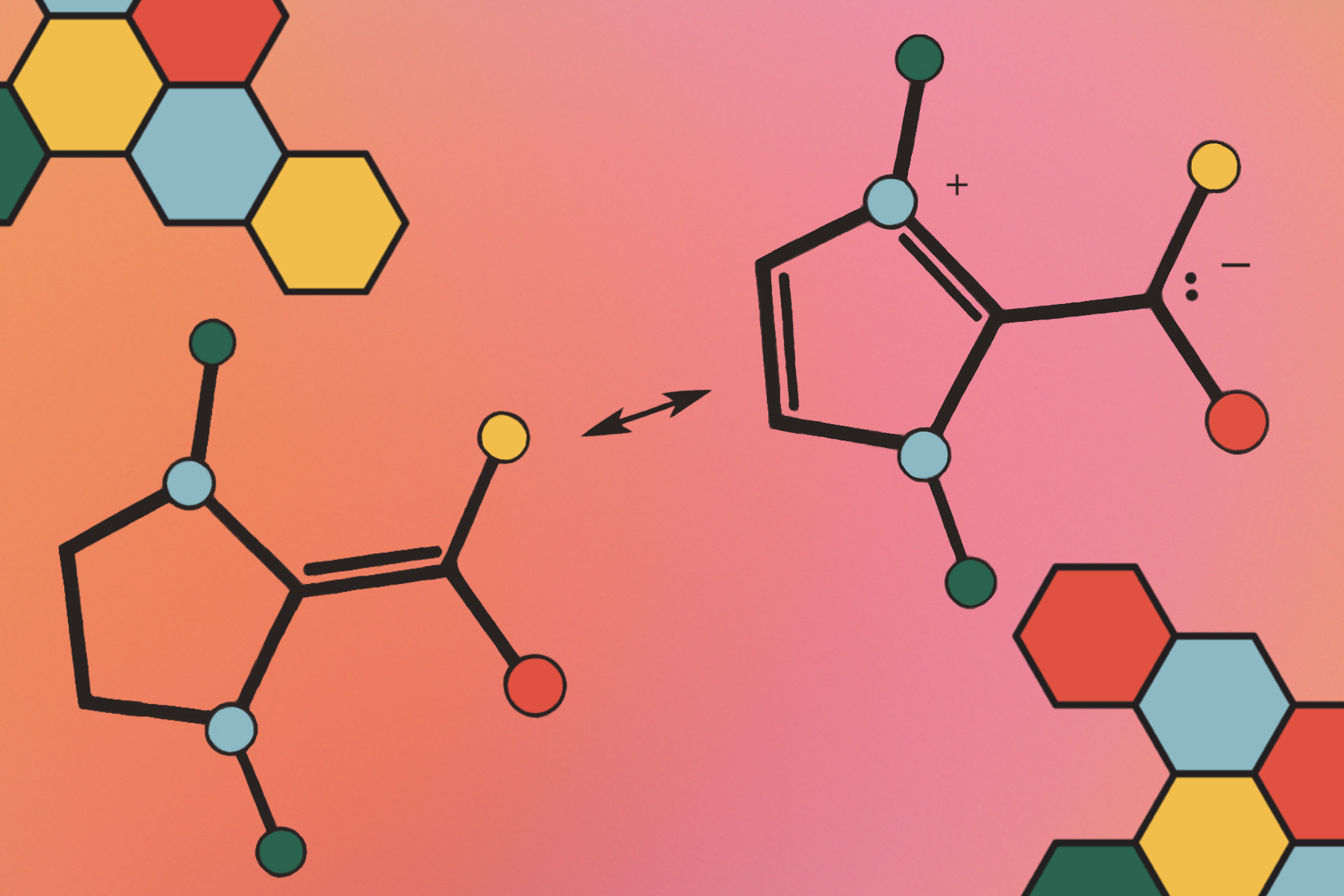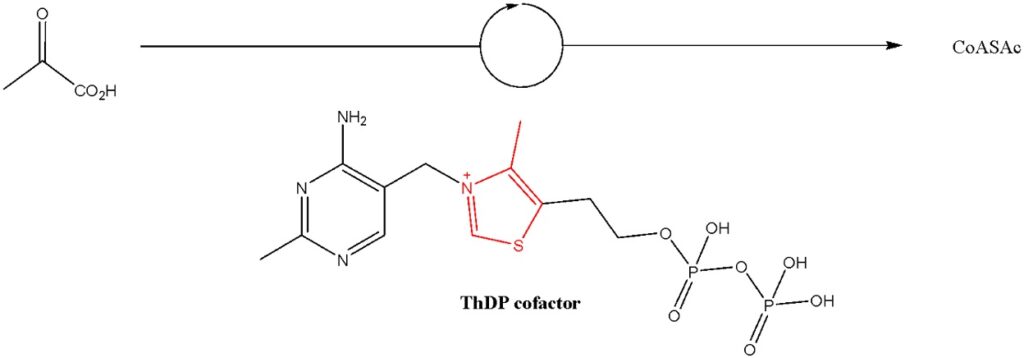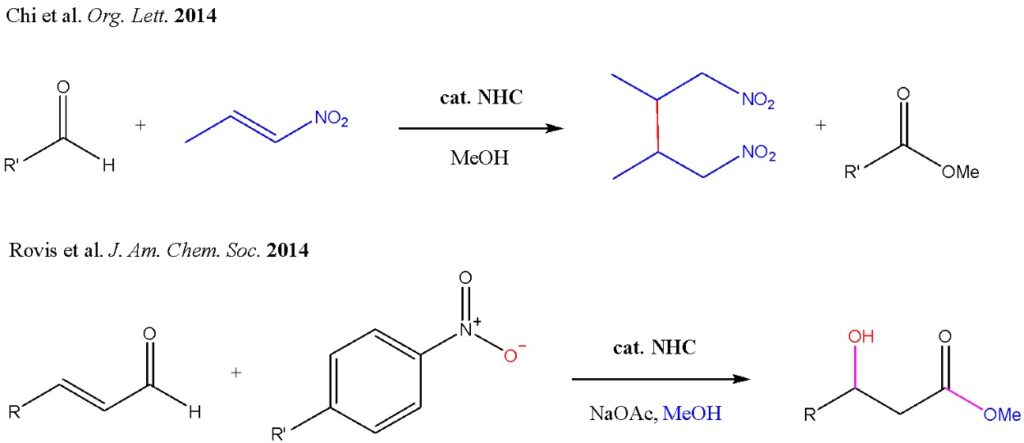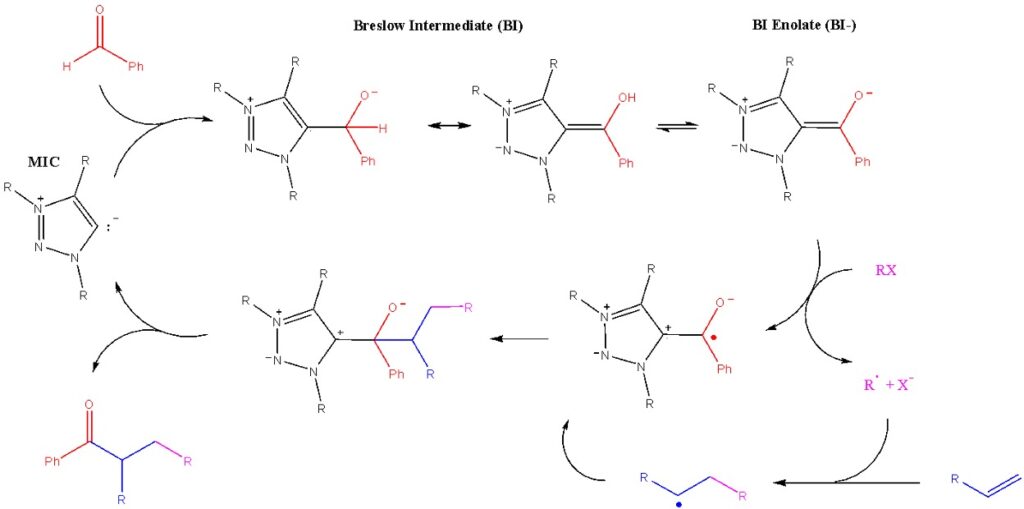
Radical Breslow Intermediates: Finding New Purpose from Carbenes
BY HAO WEI
Once laboratory novelties, stable carbenes have since found widespread application in organometallics, small molecule activation, and organocatalysis.1-6 Carbenes are formally a two-coordinate, neutral carbon center featuring six valence electrons. Singlet carbenes, by far the most common isolable example, exhibit a filled σ donating and empty π accepting orbital. In this sense, carbenes are amphiphilic, possessing the characteristics of both a nucleophile and an electrophile. In organocatalysis, this often means carbenes take on dual roles, acting as a good entering and leaving group.

For many decades, N-heterocyclic carbenes (NHC) have been known to induce umpolung (Ger. reversal) chemistry in aldehydes. Nucleophilic attack of the carbonyl carbon by the carbene followed by a proton transfer yields the Breslow Intermediate (BI). The aldehyde, which was once a strongly activated electrophile, is now a potent nucleophilic enol. BIs may go on to react in the presence of other electrophilic centers, ultimately regenerating the free NHC and forming a new C-C bond (Benzoin condensation pictured below).

Carbene-catalyzed organic coupling reactions have a rich history, and many great reviews on this topic are available. 7-10 Recently, however, Breslow Intermediates have found new applications as organic reductants in an exciting development of radical-based catalysis.11-13 In fact, the chemistry has been around for millions of years. In biological systems, decarboxylation of pyruvate involves a derivative of vitamin B1 – an N heterocyclic carbene in structure (red) – and many of the reaction steps proceed by single electron transfers (SET).14

It would not be until 2008 when Studer et al. utilized this concept synthetically to catalytically convert aldehydes into carboxylic esters with (2,2,6,6-tetramethylpiperidin-1-yl)oxy radical (TEMPO) as a mild stoichiometric oxidant.15 They proposed a mechanism whereby the carbene-derived Breslow Intermediate first undergoes a SET with TEMPO, producing TEMPO-. This basic species can deprotonate the radical cation to generate a second redox active intermediate. Subsequent reduction of a second equivalent of TEMPO and trapping of TEMPO- by the acyl azolium regenerates the carbene, completing the catalytic cycle.

Since this landmark discovery by Studer, many other oxidants have been employed, with the Breslow Intermediate either participating in the final coupling step or taking on the role of a simple reductant. In 2014, Chi et al. reported reductive coupling of nitroalkenes using aldehydes and catalytic NHC.16 The same year and the year after, Rovis and Chi independently published β-carbon hydroxylation of enals, which occurs by SET from the carbene-derived Breslow intermediate and subsequent radical recombination.17,18 In the short years to follow, polyhalides19,20 and even nitrobenzyl bromides21 would become involved as oxidant partners in this growing branch of organocatalysis.

The limitation of this chemistry, of course, lies in the reducing power of the Breslow Intermediate and the selectivity of the radical coupling steps. At least in regard to the former, recent developments suggest that carbene-derived BIs may be among the strongest organic reductants to date. In 2019, Guy Bertrand, Professor at UCSD, showed that the active reducing species of carbene-catalyzed oxidative coupling is not the Breslow Intermediate but its deprotonated form, the BI enolate (BI-).22 Electrochemical studies by Martin et al. in 2021 determined a library of BI- derived from NHCs to be powerful organic reductants, capable of accessing very mild oxidants.23 Bertrand would go on to report the aryl alkylation of alkenes using BIs derived from mesoionic carbenes (MICs).24 The mechanism (below) involves the incredible reduction of aryl iodide by BI-, trapping of the transient radical by an alkene, then radical termination to afford the MIC catalyst and arylacylated alkene. The same year, 2021, Ohmiya simultaneously published aryl radical-mediated catalysis with NHCs.25

Carbene-catalyzed radical reactions are an exciting new direction of organocatalysis. Breslow Intermediates derived from carbenes represent decade-old chemistry reimagined and offer solutions to many synthetic problems faced today. The field is in its infancy, and a lot of work is still left to be done. One day these chemical species may manifest themselves as powerful transition metal surrogates in catalytic redox chemistry.
References
A brief highlight of stable carbenes and their application (1-6)
(1) Bourissou, D., Guerret, O., Gabbaï, F. P., & Bertrand, G. (1999). Stable Car-benes. Chemical Reviews, 100(1), 39–92.
(2) Melaimi, M., Soleilhavoup, M., & Bertrand, G. (2010). Stable Cyclic Carbenes and Related Species beyond Diaminocarbenes. Angewandte Chemie International Edition, 49(47), 8810–8849.
(3) Martin, D., Melaimi, M., Soleilhavoup, M., & Bertrand, G. (2011). A Brief Survey of Our Contribution to Stable Carbene Chemistry. Organometallics, 30(20), 5304–5313.
(4) Soleilhavoup, M., & Bertrand, G. (2014). Cyclic (Alkyl)(Amino)Carbenes (CAACs): Stable Carbenes on the Rise. Accounts of Chemical Research, 48(2), 256–266.
(5) Melaimi, M., Jazzar, R., Soleilhavoup, M., & Bertrand, G. (2017). Cyclic (Al-kyl)(amino)carbenes (CAACs): Recent Developments. Angewandte Chemie Inter-national Edition, 56(34), 10046–10068.
(6) Martin, D., Soleilhavoup, M., & Bertrand, G. (2011). Stable singlet carbenes as mimics for transition metal centers. Chem. Sci., 2(3), 389–399.
NHC as a powerful organocatalyst in a myriad of reactions (7-10)
(7) Pareek, M., Reddi, Y., & Sunoj, R. B. (2021). Tale of the Breslow intermediate, a central player in N-heterocyclic carbene organocatalysis: then and now. Chemical Science, 12(23), 7973–7992.
(8) Hopkinson, M., Richter, C., Schedler, M. et al. (2014). An overview of N-heterocyclic carbenes. Nature 510, 485–496.
(9) Flanigan, D. M., Romanov-Michailidis, F., White, N. A., & Rovis, T. (2015). Organocatalytic Reactions Enabled by N-Heterocyclic Carbenes. Chemical Reviews, 115(17), 9307–9387.
(10) Wang, M. H., Scheidt, K. A. (2016). Cooperative catalysis and activation with N-heterocyclic carbenes. Angew. Chem. Int. Ed., 55, 14912-14922.
Carbenes in single electron transfer reactions, a field in its infancy (11-25)
(11) Ishii, T., Nagao, K., & Ohmiya, H. (2020). Recent advances in N-heterocyclic carbene-based radical catalysis. Chemical Science, 11(22), 5630–5636.
(12) Song, R., & Chi, Y. R. (2019). N‐Heterocyclic Carbene Catalyzed Radical Coupling of Aldehydes with Redox‐Active Esters. Angewandte Chemie International Edition, 58(26), 8628–8630.
(13) Zhao, K., & Enders, D. (2017). Merging N-Heterocyclic Carbene Catalysis and Single Electron Transfer: A New Strategy for Asymmetric Transformations. Angewandte Chemie International Edition, 56(14), 3754–3756.
(14) ChabrièRe, E., VernèDe, X., Guigliarelli, B., Charon, M. H., Hatchikian, E. C., & Fontecilla-Camps, J. C. (2001). Crystal Structure of the Free Radical Intermediate of Pyruvate:Ferredoxin Oxidoreductase. Science, 294(5551), 2559–2563.
(15) Guin, J., De Sarkar, S., Grimme, S., & Studer, A. (2008). Biomimetic Carbene-Catalyzed Oxidations of Aldehydes Using TEMPO. Angewandte Chemie International Edition, 47(45), 8727–8730.
(16) Du, Y., Wang, Y., Li, X., Shao, Y., Li, G., Webster, R. D., & Chi, Y. R. (2014). N-Heterocyclic Carbene Organocatalytic Reductive β,β-Coupling Reactions of Nitroalkenes via Radical Intermediates. Organic Letters, 16(21), 5678–5681.
(17) White, N. A., & Rovis, T. (2014). Enantioselective N-Heterocyclic Carbene-Catalyzed β-Hydroxylation of Enals Using Nitroarenes: An Atom Transfer Reaction That Proceeds via Single Electron Transfer. Journal of the American Chemical Society, 136(42), 14674–14677.
(18) Zhang, Y., Du, Y., Huang, Z., Xu, J., Wu, X., Wang, Y., Wang, M., Yang, S., Webster, R. D., & Chi, Y. R. (2015). N-Heterocyclic Carbene-Catalyzed Radical Reactions for Highly Enantioselective β-Hydroxylation of Enals. Journal of the American Chemical Society, 137(7), 2416–2419.
(19) Yang, W., Hu, W., Dong, X., Li, X., & Sun, J. (2016). N-Heterocyclic Carbene Catalyzed γ-Dihalomethylenation of Enals by Single-Electron Transfer. Angewandte Chemie International Edition, 55(51), 15783–15786.
(20) Wu, X., Zhang, Y., Wang, Y., Ke, J., Jeret, M., Reddi, R. N., Yang, S., Song, B. A., & Chi, Y. R. (2017). Polyhalides as Efficient and Mild Oxidants for Oxidative Carbene Organocatalysis by Radical Processes. Angewandte Chemie International Edition, 56(11), 2942–2946.
(21) Li, B. S., Wang, Y., Proctor, R. S. J., Zhang, Y., Webster, R. D., Yang, S., Song, B., & Chi, Y. R. (2016). Carbene-catalysed reductive coupling of nitrobenzyl bromides and activated ketones or imines via single-electron-transfer process. Nature Communications, 7(1).
(22) Regnier, V., Romero, E. A., Molton, F., Jazzar, R., Bertrand, G., & Martin, D. (2018). What Are the Radical Intermediates in Oxidative N-Heterocyclic Carbene Organoca-talysis? Journal of the American Chemical Society, 141(2), 1109–1117.
(23) Delfau, L., Nichilo, S., Molton, F., Broggi, J., Tomás‐Mendivil, E., & Martin, D. (2021). Critical Assessment of the Reducing Ability of Breslow‐type Derivatives and Implications for Carbene‐Catalyzed Radical Reactions. Angewandte Chemie Interna-tional Edition, 60(51), 26783–26789.
(24) Liu, W., Vianna, A., Zhang, Z., Huang, S., Huang, L., Melaimi, M., Bertrand, G., & Yan, X. (2021). Mesoionic carbene-Breslow intermediates as super electron donors: Application to the metal-free arylacylation of alkenes. Chem Catalysis, 1(1), 196–206.
(25) Matsuki, Y., Ohnishi, N., Kakeno, Y., Takemoto, S., Ishii, T., Nagao, K., & Ohmiya, H. (2021). Aryl radical-mediated N-heterocyclic carbene catalysis. Nature Communications, 12(1).
